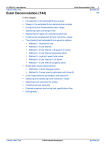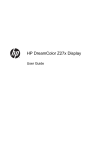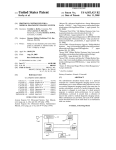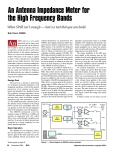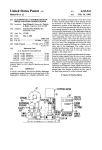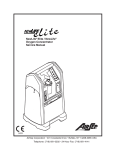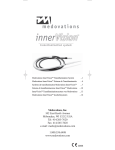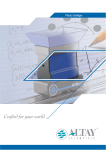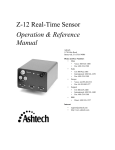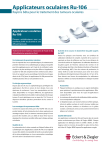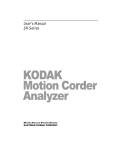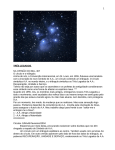Download Illlllll?l?l?llllllllllllll
Transcript
Illlllll?l?l?llllllllllllll USOO5079698A United States Patent [19] [11] Patent Number: Grenier et a1. [45] [54] TRANSILLUMINATION METHOD Scanning to Diagnose Breast Cancer: A Feasibility Study”, AJR, 142, 1984. APPARATUS FOR THE DIAGNOSIS OF BREAST TUMORS AND OTHER BREAST LESIONS BY NORMALIZATION OF AN ELECTRONIC IMAGE OF THE BREAST Brown, R. et a1., “Breast Transillumination as a Diag nostic Procedure: Does It Work?”, Abstract 305, St. Boniface Hosp. & Manitoba Cancer Foundation, Univ. Manitoba, ‘1984. [75] Inventors: Leonard E. Grenier, Whiterock; Brian V. Funt; Paul H. Orth, both of Vancouver; Donald M. F. McIntosh, Edmonton, all of Canada [73] Assignee: Advanced Light Imaging Technologies Ltd., Vancouver, Canada Bundred, N. et a1., “Preliminary Results Using Comput en'zed Telediaphanography For Investigating Breast Disease”, Brit. J. Hosp. Med., 70, 1987. Carlsen, E. N., “Transillumination Light Scanning (Diaphanography) in A Multimodality Approach to Breast Imaging”, S. Porrath, Aspen Pub., Inc. 1986. Carlsen, E. N., “Transmission Spectroscopy: An Im provement in Light Scanning”, RNN Images, 13, 22, [21] App1.No.: 346,853 ’ Date of Patent: 5,079,698 Jan. 7, 1992 1983. Cutler, M., “Transillumination as an Aid in the Diagno [22] Filed: May 3,1989 [51] 1111.0.5 ............................................ .. G061’ 15/42 1929. [52] u.s.c1. ................................. .. 364/413.13; 382/6; [58] Field ofSearch .................... .. 364/4l3.13, 413.16, Drexler, B. et a1., “Diaphanography in the Diagnosis of Breast Cancer”, Radiology, 157, 41, 1985. Girolama, R. F., and H. P. Leis, Jr., “Diaphanography: A Fourth Dimension in the Diagnosis of Breast Dis sis of Breast Lesions”, Surg. Gynecol. Obster., 48, 721, 395/132 364/413.17, 518, 521; 382/6, so, 54 References Cited ease?”, Breast, 8, 16, 1982. Greene, F. L. et a1., “Mammography, Sonomammogra U.S. PATENT DOCUMENTS phy and Diaphanography (Light-Scanning)”, The [56] 4,286,602 9/1981 Guy ................................... .. 128/665 4,312,357 4,407,290 10/1983 1/1982' Wilber Anderson ............. et a1. .. 4,420,742 12/1983 Tadauchi et a1. . 4,467,812 4,495,949 4,515,165 8/1984 1/1986 Stoller ............. .. Stoller ..... .. 128/664 128/664 5/1986 Carroll .... .. 128/664 4,566,125 'l/l986 American Surgeon, 51, 58, 1958. Gros, C. M. et a1., “Diaphanologic Mammaire", J. Radiol. Electrol. Med. Nuc1., 53, 297, 1972. Hardy, J. D. and C. Muschenheim, “The Radiation of Heat from the Human Body. IV The Emission, Re?ec tion and .Transmission of Infra-red Radiation by the Human Skin”, J. Clin. Invest. 13, 817, 1934. 4.761,819 8/1988 Denison et a1. 382/6 Holliday, H. W. and R. W. Blarney, “Breast Transillu mination Using the Sinus Diaphanograph”, Brit.‘ Med. Journal (Clin. Res), 283, 411, 1981. Hussey, J. et a1., “Diaphanography—A Comparison With Mammography and Thermography”, Brit. J. 4,856,528 4,907,156 8/1989 Yang et al. ...... .. 3/1990 Doi et al. .... .. 382/6 382/6 Isard, H. J., “Breast Disease and Correlation of Images: Clunn ..... ...... . 4,570,638 2/1986 Stoddart et al. 4,600,011 7/ 1986 Watmough 4,616,657 10/1986 Stoller ......... .. 4,618,937 10/1986 Elias et a1. . . . .. 382/48 128/665 128/664 .... .. 382/6 4,947,323 8/1990 Smith ................................... .1: 382/6 Radiol., 54, 163, 1981. Mammography-ThermographyDiaphanography”, Biomedical Thermology, 321-328, 1982. Lafrenier, R. et a1., “Infrared Light Scanning of the Breast”, The American Surgeon, 52, 123, 1986. Mallard, J., “The Noes Have It! Do They?”, Silvanus Thompson Memorial Lecture, British Journal of Radi OTHER PUBLICATIONS Angquist, K. et a1., “Diaphanoscopy and Diaphanogra phy for Breast Cancer in Clinical Practice”, Acta Chir. Scand., 147,231, 1981. Bartrum, R., Jr. and H. Crow, “Transillumination Light ology, 54, 831, 1981. SELECT mm "AGE 1n‘ Emmet amuse 5,079,698 Page 2 Marshall, V. et al., “Diaphanography as a Means of Methods in Breast Imaging, 2nd Ed., pp. 169-177 Detecting Breast Cancer", Radiology, 150, 339, 1984. (1987). McIntosh, D. M. F., “Breast Light Scanning: A RealTime Breast-Imaging Modality”, Journal of the Cana dian Association of Radiologists, 34, 288, 1983. Merritt, C. et al., “Real Time Transillumination Light Scanning of the Breast”, Radio]. Graphics, 4, 989, 1984. Morton, R. and S. Miller, “Infrared Transillumination Using Photography and Television (Videoscopy)”, J. Audiovisual Media. Med, 4, 86, 1981. Ohlsson, B. et al., “Diaphanography: A Method for Evaluation of the Female Breast”, World Journal of Surgery, 4, 701, 1980. Wallberg, H. et al., “Investigation with Diaphanogra phy, Mammography and Cytological Examination for Diagnosing Breast Cancer”, Report Huddinge Hospi tal, Sweden, 1978. Watmough, D. J ., “A Light Torch for the Transillumi nation of Female Breast Tissues”, British Journal of Radiology, 142, 1982. Watmough, D. J., “Diaphanography: Mechanism Re sponsible for the Images”, Acta Radiologica Oncology, 21, 11, 1982. Watmough, D. J ., “Transillumination of Breast Tissues: Factors Governing Optimal Imaging of Lesions”, Radi ology, 147, 89, 1983. D’Orsi, Carl J. et al., “Lightscanning of the Breast”, Breast Cancer‘ Detection: Mammography and Other Primary Examiner-Gail O. Hayes [57] ABSTRACT A method and apparatus for enhancing the contrast of a local area of interest within an electronic image of an object, such as a female breast, which has been transillu minated by non-ionizing radiation such as light or sound. The area of interest may be a cancerous tumor, cyst or another object which differentially absorbs or transmits the radiation. Enhancement of contrast is by normalization of the electronic image. Normalization includes modeling the illumination ?eld of the image to compensate for the non-uniformity of the illumination ?eld, and then combining the modeled ?eld with the original image. Four normalization processes are dis closed: Gaussian curve ?tting, geometric mean smooth ing, arithmetic mean smoothing, and arithmetic mean smoothing only within the boundary of the local area of interest. Also disclosed is a process for highlighting local areas which are the result of enhanced transmis sion of the radiation, such as potential cyst sites, and color mapping more than .one displayed image. The normalized image may be displayed for analysis. 44 Claims, 6 Drawing Sheets US. Patent IIIIII 1 ‘ IIIIIIIE ‘ III-III 2:552:22; Jan. 7, 1992 Sheet 1 of 6 5,079,698 US. Patent ' Jan. 7, 1992 Sheet 3 of 6 5,079,698 MAIN MODULE I REVIEW ACQUIRE FIG. 40 ACQUIRE I PATIENT F04 INFORMATION ENTRY *I LIGHT OR ULTRA SOJND IMAGE / I COLOR CHECK CALIBRET ION FREEZE DND CAPTURE IMAGE ACCEPT AND STORE IMAGE PATENT PD _DATA BASE woaxms W "STORAGE (HARD DRIVE) PD FIG. 4b ARCHIVE US. Patent Jan. 7, 1992 Sheet 4 of 6 5,079,698 /; iwsm .PZwE zor wu 5\\2 E Hi2. om “5.2?03 825 ;.15O258: US. Patent Jan. 7, 1992 Sheet 5 0f 6 5,079,698 w35 40 Qg2mo1h0; .32509mO.la0d-2.50+25.» 5oz_32<sm 1 o I 5w.z3EcuH%im2o<"s. // wz um;q oa0>>wMiB2dE1e95m2 . g3.wE9.5%; 0n.Pw@zu<52Fm69oE5m am ;ao E5oPU.k:zEw 5: 24 86.3250‘ 5,079,698. 1 TRANSILLUMINATION METHOD APPARATUS FOR THE DIAGNOSIS OF BREAST TUMORS AND OTHER BREAST LESIONS BY NORMALIZATION OF AN ELECTRONIC IMAGE OF THE BREAST cRoss REFERENCE TO RELATED 2 image enhancement processes to aid the medical practi tioner in identifying lesions of interest, particularly can- _ cerous tumors. Notwithstanding the substantial interest in the transil lumination of non-ionizing electromagnetic radiation for diagnosis of breast lesions, the technique has not met with general acceptance among medical practitioners. Although the speci?c reasons for the technique’s lack of acceptance are many and varied, in general it has not APPLICATIONS This application relates to subject matter described in Canadian Application No. 539,503-8 ?led June 12, 1987 0 been accepted as a clinically reliable substitute or ad7 and in U.S. patent application No. 07/150,335 now junct to X-ray mammography. The principal problem abandoned ?led Jan. 29, 1988 by Advanced Light Imag appears to be the technique’s inability to detect lesions ing Limited Partnership, and invented by Leonard E. unless they are close to the breast surface or there is Grenier; Brian V. Pam; and Paul H. Orth, this applica otherwise a large contrast between the lesion and the tion being a continuation-in-part of said Canadian and remainder of the image. U.S. patent applications. Transillumination of the female breast for diagnostic BACKGROUND OF THE INVENTION I. Field of the Invention This invention relates to a method and apparatus for purposes was proposed at least as long ago as 1928, and reports of the clinical use of a high intensity light source to illuminate the interior of a breast date back to 1929. enhancing images of transilluminated materials wherein The procedure was abandoned because it had only a the area within the image containing the information of interest is the result of differential absorption of the limited ability to distinguish benign and malignant tu mors. transmittal energy and/or exhibits low contrast. This invention also relates to a transillumination method and The procedure was resurrected in the 1970s when a water cooled high intensity light source to improve apparatus for the diagnosis of breast tumors and other illumination was combined with a photographic camera breast lesions using nonionizing radiation energy such which recorded black and white and infrared images. The apparatus proved to be bulky and the actual exami nation required long exposure times in a completely as light or sound. More particularly, this invention re lates to a method and apparatus for digitally enhancing localized areas of interest in the resulting image of a breast to aid in the diagnosis of malignant tumors, cysts and other lesions. As used herein, transillumination is intended to cover the transmission of both light and sound through an object or material at the appropriate dark examination room. herein may be applicable to electronic images resulting that abnormal breast tissue absorb light differently than normal tissue, and photographs of. transilluminated Improvements continued. In 1979, a small hand-held device called a “diaphanoscope” was introduced. This unit contained a broad spectrum light source, ?ber op tics and a fan that air-cooled the system. Images of the wavelength transmission range (window). Although light and sound are the known non-ionizing forms of 35 illuminated breast were photographically recorded. Reports of clinical use of the diaphanoscope indicate radiation, the image enhancement processes described from other forms of transillumination. ' breast were considered to be good but did not add any 11. Description of the Prior Art Transillumination of the breast with light to assist in 40 new or significant data to breast examination that could not be obtained with X-rays or palpation. It was how the detection and diagnosis of malignant tumors is ever determined that transillumination effectively illu known. Generally, the technique involves passing light in approximately the 600-1000 nanometer wavelength minated the more dense breasts of younger women. Subsequently, infrared light detecting cameras and range through the breast, and directly examining the breast or a recorded image of the breast for the presence of lesions. The lesion may be observed because the 45 highly sensitive television cameras and monitors were used to obtain a real-time image that the medical practi vessels. Cancerous lesions of interest are ?lled with and tioner could view during an examination. Images could be stored, compared to the other breast and photo surrounded by blood which strongly absorbs light in the selected wavelength range. Moreover, such lesions the monitor. absorb the light more strongly than the breast’s blood vessels. Thus, malignant tumors may be detected be and color photographs taken with infrared sensitive cause they are more optically dense than the remainder of the breast tissue. film. This work was followed by the digitization of breast human breast comprises fat, ?brous tissue and blood graphed using a Poloraid or 35 mm camera attached to Still other work involved the use of ?ash exposure A major advantage of using light is the avoidance of 55 images, storage and, to a limited degree, processing of ionizing radiation such as X-rays. This advantage is also the stored information. Also “false color” was incorpo applicable to other forms of nonionizing radiation en rated to give enhanced differentiation to the images. ergy such as ultrasound. Although not as useful in imag Spectrascan, Inc. of South Windsor, Conn., USA offers ing cancerous breast lesions, ultrasound does generate a commercial embodiment of a breast illumination sys images of some lesions such as cysts as a result of differ 60 tem incorporating the use of a video camera, digitiza ential absorption, and therefore the present invention is applicable to those images. Optical and electro-optical apparatus have been de veloped to aid in using the transillumination technique. These apparatus have incorporated improvements in 65 tion of the breast image, algorithmic image reconstruc television cameras and monitors. Moreover, television tion, ampli?cation, and display in black-and-white on a video monitor. (See US. Pat. Nos. 4,467,812 and 4,485,949 which relate to the Spectrascan, Inc. transillu mination method and apparatus.) More recent apparatus have incorporated freeze frame capability to permit a stable image for photogra cameras have been coupled with analog and digital phy and/or digitization. The apparatus is also provided the light source, photographic imaging and the use of 3 5,079,698 with the capability to digitally record and retrieve the 4 herein, prior light scanning apparatus lacks sensitivity in images. of patient populations, diagnostic imaging techniques cyst detection relative to ultrasound. There therefore is a need for a more sensitive process and apparatus for transillumination diagnosis of breast and clinical exams have been done. In general, these lesions using non-ionizing radiation (e.g. light scanning studies show that electromagnetic transillumination or sound) to generate a clinically useful image. It is particularly desirable that such process, and the appara tus for carrying out the process, be more sensitive to the detection of occult, non-palpable breast cancer. Approximately 25 clinical studies using a wide range (also referred to as light scanning) has promise as a breast examination system separate from palpation, X-ray mammography and ultrasound. However, the results of the ~studies do not correlate suf?ciently to 10 SUMMARY OF THE INVENTION permit widespread acceptance of light scanning as a diagnostic technique. One study concluded that X-ray mammography is far superior to light scanning. How When an electromagnetic wave such as light im pinges on biologic tissue, two effects occur: scattering ever, another study concluded that infrared light scan ning of the breast is effective in the hands of trained and absorption. In the case of a pressure wave such as ultrasound, the effects are absorption and re?ection. Scattering, absorption and re?ection attenuate the light personnel and it should be used as an adjunct to routine breast examination or X-ray mammography to increase or sound. The hemoglobin in blood strongly absorbs the detection of breast pathology. light in the red/near infrared region of the electromag netic spectrum-650 nM to 950 nM. Thus, blood vessels “A clinical study comparing transillumination light scanning using a Spectrascan Light Scan Model 10, and 20 and malignant tissue, which are ?lled with and sur screen-?lm mammography of the breast was made in 1987. The authors of the study concluded that transillu rounded by blood, absorb such light relative to the other breast tissue; i.e. lobe, ligament, skin, fascia and mination light scanning is not competitive with X-ray fatty tissue. This differential absorption results in an mammography as a screening method for breast cancer observable contrast within an image of the breast. Ultra detection. Furthermore, they were unable to identify a 25 sound also is differentially absorbed and produces an select subpopulation of women who might bene?t from observable contrast within an image. light scanning as an adjunct to X-ray mammography. A study conducted a year earlier, also involving the Spectrascan Light Scanner, suggested that X-ray mam mography was superior for detecting malignancy. Notwithstanding the foregoing, the clinical studies However, image clarity does not necessarily result from differential absorption of the transilluminated 30 light. Transillumination is hampered by the scattering that light experiences when passing through the breast. Attenuation due to Rayleigh scattering is one to two suggest that light scanning has an adjunctive value; that orders of magnitude stronger than absorption, primarily is, by using X-ray mammography and light scanning due to the fact that skin can be considered to be a nearly side by side, the overall reliability of imaging for breast perfect light scatterer. The breast transillumination disease may be improved. 35 phenomenon is very similar to the transmission of light Several important points may be derived from the through a glass of milk. I conclusions of the light scanning clinical studies. These In practice this means that a light absorbent mass within the breast in effect casts a shadow on the skin; that is, the observed image is the mass’ shadow on the rently available equipment is not nearly so sophisticated 40 skin. As with all shadows, there is a problem of mar include: ' 1. Light scanning is effective even though the cur as X-ray and ultrasound equipment. 2. Light scanning is safer than X-ray mammography ginal de?nition; the closer the object to the surface, the sharper the margins of the shadow. As the object cast ing the shadow moves farther from the surface, the because there is no ionizing radiation. 3. Light scanning is highly complimentary to X-ray mammography rather than being a competitive imaging system. 4. Light scanning suffers somewhat because medical margins become less distinct; i.e., the wider the shad 45 ow‘s penumbra. This loss of marginal de?nition may be called “shadowing”. . Shadowing has particular effect in the detection of breast tumors using transillumination of light. It ex plains why deep seated tumors are difficult to detect practitioners are not familiar with light scanning proce dures. 5. Light scanning has particular applicability as a 50 while those closer to the skin surface are more readily screening procedure for women between the ages of 30 observable. The shadows of a small deep seated tumor may be so diffuse as to be nearly or entirely undetect and 40 who would otherwise receive a X-ray mammo gram every two years and women over the age of 40 able by the human eye. Light scanning technique takes who should have a mammogram every year but do not different views of the breast to decrease its thickness, want X-ray exposure. Light scanning has particular 55 thereby bringing the shadowing objects closer to the value as an adjunctive diagnostic tool for yearly breast examination in women under the age of 30, high risk patients and cancer patients. skin surface to minimize the penumbra effect. But at best this is only a partial solution to the problem of providing an image in which the contrast between the Clinical studies aside, particular problems with exist lesion of interest and the remainder of the image is ing light scanning apparatus include inability to clearly 60 suf?cient to be useful to the medical practitioner. perceive deep lesions and tumors located near the chest The fact remains that the shadowing effect in transil wall. Existing apparatus have dif?culty in detecting lumination obscures the detection of many malignant minimal, non-palable tumors and also produce poor results for patients with clinically occult malignancies. tumors. The present invention overcomes shadowing and Still further, existing light scan apparatus have not been 65 other problems inherent in using transillumination to useful in recent biopsy, aspiration, trauma or hemor detect breast lesions. As already noted, lesions of inter rhage patients because of the presence of light absor est will differentially absorb light. The problem lies in bent hemoglobin. Signi?cant to the invention described providing an image of the breast lesion which can be 5 5,079,698 6 detected by a medical practitioner. More particularly, cyst process or routine highlights areas within an image _ the present invention provides a method and apparatus for enhancing localized areas in the image of a breast to normalized by anyone of the normalization routines herein described, as regions of increased intensity due to make them more readily observable by the medical practitioner, and therefore make transillumination more useful in the detection of lesions such as malignant tu ous tumors. mors and cysts. ping more than one image at a time. In accordance with the present invention, a breast is transilluminated with light in 650 nM to 950 nM wave Although the primary purpose of the present inven tion is to provide enhanced images for the diagnosis of length region. The light traversing the breast is detected by a video camera, and a video signal is generated. The video signal is digitized and processed by normalization routines to provide an image which enhances the local areas representing light absorptive masses within the the fact that cysts are fluid ?lled, not solid as are cancer Finally, the present invention provides for color map breast tumors and other breast lesions, the normaliza tion of the image has other applications, particularly where the localized image area containing the informa tion of interest is the result of differential absorption (or transmission) of the transilluminating electromagnetic breast. 15 or sound energy or exhibits low contrast. For example, A video signal may also be created by use of ultra the method and apparatus of the present invention may sound (usually 3 to 10 MHz) according to accepted techniques and practices for such instruments. In accor dance with the present invention, the resulting video signal is digitized and processed to provide an image 20 be useful for locating parasites in ?sh tissue or plastic contaminants in wood pulp. BRIEF DESCRIPTION OF THE DRAWINGS The present invention may be embodied in other speci?c forms without departing from the spirit or es sential attributes thereof and, accordingly, reference components namely ( 1) a light (or sound) ?eld compo should be made to the appended claims, rather than to nent (illumination) and (2) an absorption component. 25 the foregoing speci?cation, as indicating the scope of The ?eld component is non-uniform primarily because the invention. the light or sound source is effectively a point source. FIG. 1 is a front elevation of the console for the The absorption component is made more dif?cult to present invention showing the video monitor, keyboard observe because shadowing erodes the margins and reduces contrast. Processing the image using normaliza 30 and light source. FIG. 2 is a longitudinal sectional view of the light tion routines according to the present invention accen source. tuates areas of the image representing areas of locally FIG. 3 is a block diagram of the image processing high absorption within the breast. elements of the present invention. . In different terms, the ?eld component has been de FIGS. 40, 4b, 4c and 4d are block diagrams showin termined to have a low spatial frequency, whereas the 35 the functional organization of the system software used absorption component has a much higher spatial fre for the present invention. . quency. The normalization routines of the present in FIG. 5 is a block diagram of an ultrasound source of vention reduce or remove the effect of the low spatial radiation for use in the present invention. ' frequency ?eld to enhance the image's local area of interest which is due to absorption or another causitive 40 DESCRIPTION OF THE PREFERRED effect resulting in higher spatial frequency. EMBODIMENT Normalization of the image is accomplished by ap With reference to the drawings and in particular to proximating, smoothing or averaging (i.e. modeling the FIG. 1 thereof, there is shown an apparatus 10 for the ?eld) the ?eld component, and then enhancing the con trast by taking the ratio of the original ?eld intensity to 45 diagnosis for breast tumors and other breast lesions. Apparatus 10 includes a cabinet 12 for housing the com the modeled ?eld or otherwise subtracting it out. puter and other electronics which are part of the pres As used herein, the term “normalization” is intended ent invention. A video monitor 14 is mounted on the to refer generally to the four image enhancement pro cabinet 12, as is keyboard 16 for the computer used with cesses which are part of this invention. As such, it is to the present invention. Also shown in FIG. 1 is a ?berop be distinguished from other uses of “normalization” (or tic bundle 18 extending from a light source (shown in “norma1izing”) as may appear in the prior art. FIG. 2) to hand piece 20. A video camera 22 is mounted Four different normalization routines compensate for on the cabinet 12 by means of a stand 24 with appropri different kinds of images. Gaussian curve ?tting is used ate articulating mechanisms to permit universal adjust for general ‘purpose enhancement of a wide range of image quality. Geometric mean smoothing is used for 55 ment of the camera 22 for bringing it into alignment with a patient’s breast. The camera will ordinarily be low contrast images with poorly differentiated breast positioned at various angles above the patient’s breast. outlines and backgrounds which include a lot of detail. The flexible ?beroptic bundle is used with the camera to Arithmetic mean smoothing is used for either high or take different views of the patient’s breast. These views low contrast images with poorly differentiated breast outlines or with distinct detail in the background of the 60 are standardized, and therefore need not be described herein. image. Normalization by arithmetic mean smoothing The light source used with the present invention is with boundary detection is used for high contrast im shown in FIG. 2. Such source includes a housing 26 on ages with well differentiated breast outlines, and dark which is mounted a cooling fan 28. Within the housing background containing little or no distinct detail. In addition to image enhancement by normalization 65 is mounted a 50 watt lamp 30 which may be an Osram Model 41980SP or 4l990SP. Mounted in front of the as described herein, the present invention provides a with enhanced local areas representative of differential absorption within the breast. The image under consideration is made up of two process for highlighting regions in the breast image which are potential cyst sites. More particularly, the lamp 30 is a lens condenser 32 which may be a Melles Griot Model 01LAG019. Positioned in front of the lens 7 5,079,698 8 32 is a ?lter 34 which may be a Toshiba 25A or Melles maps input data to a gray scale which, for this inven Griot 03MCS005. The lamp 30, lens 32 and ?lter 34 provide light to the tion, is a range of gray levels from 0 to 255. 1 ?beroptic cable 18 in the 650 nM to 950 nM range. The ?beroptic bundle within cable 18 is approximately 5 inch in diameter and terminates with the end piece 20. The intensity of the light at the hand piece 20 is approxi The output of the input lookup table 50 is transferred to a frame buffer RAM 52, which is used to store frame grab data. A CRT controller (CRTC) 54 has access to the frame mately 1.2 to 1.5 watts. buffer, and sends pixel data to the output lookup tables 56, 58 and 60. In a preferred embodiment of the present invention, the video camera 22 is a charge coupled device (CCD) The frame buffer 52 is read and write accessible from the computer using it, y coordinates. which is sensitive to light in the preferred wavelength Data that are written from the PC bus to the video digitizer pass through a bit mask 62. This mask is set up through software and enables the user to selectively era provides an image which can be set up in a desired write data from the system to the frame buffer 52. Data pixel array as hereinafter described. One such camera which meets the requirements of the present invention 5 are stored in the frame buffer 52 from the input lookup table 50 when frame grabbing is active. is a Photon CCD Model P453l0 monochrome camera When a frame is grabbed, it is taken from the selected available from EEV Solid State Devices of Rexdale, port and digitized. It then passes through the input Ontario, Canada M9V 3Y6. The EEV Model P4541O lookup table 50 and is stored in the frame buffer. may also be used with the present invention. FIG. 3 shows in block form the electronic apparatus 20 The PIP-1024b has two video modes: one 1024 X 1024 image or four 512 X512 images. Both video formats used for the present invention. have a 512x 512 pixel display space and can be scanned As shown, the analog video signal from the CCD horizontally and vertically by properly selecting the ' video camera 22 is ampli?ed by the video gain circuit address in the CRTC 54. 38. In the preferred embodiment, video gain circuit 38 There are two sources of data for output from the provides 12 dB of ampli?cation for the analog video video digitizer: the frame buffer 52 and the input lookup signal. table 50. The user can select either video keyer 64, or The ampli?ed video signal is supplied to a video simply the output from either the frame buffer 52 or the digitizer board 40. The video digitizer board 40 is an input lookup table 50. This results in both the contents electronic device that allows a computer to perform of the frame buffer and the input lookup table being frame grabbing operations on a video signal from an displayed, giving the ability to overlay video onto the external source. Video digitizers are known, and the input video signal. range, namely 650 nM to 950 nM. Moreover, the cam particular video digitizer used in conjunction with the present invention is a commercially available device. In particular, the video digitizer board 40 is a PIP-1024b available from Matrox Electronic Systems Ltd. of Dor val, Quebec, Canada H9? 2T4. For a more detailed disclosure of the PIP-1024b video digitizer board, refer ence should be had to the PIP hardware manual 238MH-0OREV.3 dated Sept. 2, 1986 and the user man ual 238MU-0OREV.2 published by Matrox Electronic Systems Ltd. and available with purchase of the PIP l024b video digitizer board. This video digitizer board is compatible with the IBM PC, XT and AT computers or other compatible computers. The computer used with the present invention is a Compaq 386 computer. The PIP-1024b displays the image in an x-y pixel format or array. Each pixel is represented by eight bits, The output lookup tables 56, 58 and 60 each received all eight bits of video signal. These tables use one of their stored maps to generate a new value. These values can be used to generate 256 shades of gray or 16.7 mil lion colors. These colors are actually pseudo- or false ' colors. This means that the colors do not represent what the camera sees but rather represent a level of intensity. The system can assign different colors to gray levels which are very close thereby allowing the observer to distinguish details with much greater ease, and even when the output is grays only. The output of each of the lookup tables 56, 58 and 60 is sent to a set of digital to analog converters 66 which produce, in real time the three analog signals for the RGB output which may be accepted by the video moni- , tor 14. and each pixel can be displayed in a set of gray levels The basic functional elements of the video digitizer from 0 to 255, with the lower levels representing the 50 board 40 have only been brie?y described. For a full darker grays. description of their function and operation, reference As shown in FIG. 3, the video signal is selected in should be made to the user’s manual for the Matrox software from one of three input ports on the video PIP-1024 video digitizer board cited above. digitizer board 40. In this embodiment, the video signal Patient data are stored in the optical disc drive 70 is taken from input 1. The video signal for ultrasound is 55 and/or the hard disc drive 72. Data and the programs taken from input 3. for operation of the system are stored in the hard disc The input signal is passed through a sync signal sepa drive 72. rator 40, and a DC offset voltage 46 is applied to center Having described the hardware for accomplishing any portion of the video signal in the operating range of the purposes of the present invention, the software rou the analog to digital converter 48. A gain adjustment is tines for accomplishing the purposes of the present also applied to adjust the amplitude of the input signal (i.e. make the picture brighter or darker). The video input signal is digitized by the analog to digital converter 48 to provide the requisite eight bit number. The eight bit number is sent to the input lookup table 50. The lookup table 50 maps the incoming data to values set up by the user. The input lookup table is loaded from the personal computer. The lookup table invention will now be described. One of the basic principal purposes of the present invention is to normalize the electronic image generated by the apparatus 10. Image normalization has two pur 65 poses. One purpose is to compensate for the non uniform light ?eld produced by the light source. The light source is, of course, the light emanating from the end piece 20 of the ?beroptic bundle 18. This light 9 5,079,698 source is effectively a point source; that is, it has a 10 out the modeled ?eld or taking the ratio described _ bright central point with radially decreasing intensity. above. Thus, the process smooths the ?eld component The present invention compensates for the radially by identifying the spacial frequency variations and at least partly removing them. Having described the assumptions upon which the decreasing intensity of this light ?eld. The second purpose of the invention is to accentuate areas of locally high light absorption within the breast region of the image. As already noted, malignant le sions, as well as blood vessels are characterized by rela tively high light absorption because hemoglobin ab sorbs light in the selected wavelength range. However, because of the shadowing effect, the contrast in the image due to the presence of such lesions or other areas of interest is so subtle as to be effectively indistinguish able to the practitioner. The present invention accentu ates these areas within the image to make them more visible. The invention also accentuates local areas represent ing sound absorption or re?ection. Although four normalization routines using different algorithms are described herein, they are all based on present invention is based, the normalization routines to compensate for the non-uniform ?eld and to accentuate areas of locally high absorption can now be described. The description will focus on an image created by trans illumination using light but the principles described are applicable to images resulting from the use of ultra sound. The ?rst normalization routine can be characterized as normalization by Gaussian curve ?tting. This is ac complished as follows. Initially, the input image is stored in one of the four quadrants of the frame buffer memory 52, which may also be referred to as a frame grabber memory. The frame buffer memory 52 is capable of storing four the following assumptions. 512x512 pixel images, in four different quadrants. First, it is assumed that the image data is made up of two components—a light ?eld (illumination) compo nent and a light absorption component both of which image from CCD camera 22 is digitized to a 5l2><480 include spatial frequency variations. For ultrasound the image can be considered to be sound ?eld component and an absorption or re?ection component. Second, it is assumed that the ?eld component and the absorption component are related as follows: For the purposes of the present invention, the input pixel format and is stored in one of the four quadrants of 25 the memory 52. As noted above, each pixel is repre sented by an eight bit number; that is, eight bits or a byte represent the gray level of one pixel in a range of 0-255 with the lower levels being the darker grays. The image to be normalized is read from memory 52 30 into the computer memory on a line by line basis. Each where E is energy, and is represented by the light or sound intensity of the image; I is the light or sound ?eld component; and A is‘ the absorption component. In practical terms, the formula states that for any given pixel in the‘ input data image, the gray level of that pixel is a product of an illumination component (I) and an absorption component (A). The third assumption is that the ?eld component is the dominant information in the breast or other image, but that the absorption component is of most interest in terms of medical diagnosis or otherwise. The fourth assumption is that the ?eld varies only gradually across the image (i.e. is of low spatial fre quency) whereas absorption varies much more rapidly of the eight bit numbers is converted to the internal numeric representation of its gray level within the com puter. Normalization of the image as stored in the computer 35 is done line by line. First, each pixel in a line is con verted to its' logarithm and stored as a sixteen 'bit inte ger, hereinafter referred to as a data ~logpixel. Natural logarithms‘ (base e) are used. Next, a set- of regularly spaced data logpixels on each line are used to develop a Gaussian distribution curve determined by the least squares method. Typically, thirty regularly spaced data logpixels on each line are chosen. A standard least square’s curve ?tting method is used to ?t a quadratic ‘equation to these data logpixels. The quadratic equation y=a0+a1x+a2x2 is used. It has three independent pa rameters, a0, a1 and a; which are calculated for each line using the aforesaid regularly spaced data logpixels. and therefore contains higher spatial frequency infor The next step in the routine is to normalize the line by mation. taking each curve ?tted logpixel, subtracting the data 50 The ?fth assumption is that an approximation to the logpixel, and adding a selectable normalization constant absorption component can be recovered from the raw to obtain a normalization logpixel. A typical normaliza data image by modeling the ?eld component and per tion constant usable with the present invention is 128. forming the division A = E/l (Model) on a pixel by pixel or other basis. Although applied on a pixel-by-pixel basis as de scribed herein, this invention is not so limited. The normalization and other processes described herein may be applied on a line-by-line, vector or matrix basis. The normalization process assumes that the ?eld component is of low spatial frequency, whereas the spatial frequency of the absorption component is much The resulting normalized logpixel is next compared 55 to a threshold amount. The threshold amount is typi cally chosen as antilog [[logpixel]X 12]. If the resulting normalized data logpixel is less than the threshold amount, then that part of the line is normalized to only the threshold amount. The foregoing is repeated for each line. Next, using a special lookup table, the antilogarithm for each normalized pixel is calculated. The normalized pixel data is converted from integer representation in the computer to eight bit format and transferred to the higher even though its magnitude in relation to the total 65 frame buffer 52. All lines of the image array of pixels are ?eld component is small. The invention therefore re moves the ?eld component at least in part by approxi mating or otherwise modeling it, and then subtracting so normalized until the entire normalized image is now in the frame buffer. The normalized image is then dis played on the video monitor 14. 11 5,079,698 In more general terms, the foregoing routine creates a model of the illumination ?eld which approximates a Gaussian distribution for each line. The actual video signal is a low level signal whose illumination ?eld is 12 each column in the pixel array. A weighted average _ may be used. In accordance with the routine herein described, the image is normalized by taking the ratio of the input image to the smoothed image, on a pixel by pixel basis. relatively convoluted due to the presence in the image of the edge of the breast, blood vessels, and possibly a tumor. By subtracting out the approximate Gaussian distribution model of the illumination ?eld, variations The resulting ratio is then scaled so that the pixel values lie within a preselected range of gray levels of 0-255. Also the values may be stretched over the gray scale overall light ?eld. range. Stated otherwise, the geometric average for the surrounding area for each pixel is calculated, and then the aforesaid ratio is determined on a pixel by pixel basis. Normalization of the breast image by Gaussian curve ?tting is used for general purpose enhancement of a The geometric mean is taken for the area by averag ing the logarithm of each pixel in the local area. The - are smoothed but sharp discontinuities due to the ab sorption component remain and are enhanced even though they are of low magnitude in relation to the wide range image quality. 15 pixel by pixel image ratio may be performed using loga rithm and antilogarithm lookup tables. Another routine for compensating for the non The execution time for determining the geometric uniform light ?eld and accentuating areas of locally mean for each area surrounding each pixel may be re high light.absorption may be described as geometric duced by usingscaled logarithms stored in a lookup mean smoothing. In general, this routine involves com paring an input image pixel with a surrounding local 20 table and two passes of a one dimensional averaging mask instead of one pass of a two dimensional mask, as area, and looking for areas of relatively high absorption. well as a moving window averaging algorithm. More particularly, the routine involves examining a The normalized image is transferred from the com selected optical area surrounding each pixel in the puter to the frame buffer memory 52 and displayed. In image to look for subtle changes in contrast. The sur a preferred embodiment, the normalized image is dis rounding area has been determined experimentally al played below the sampled original image on the video though in general it depends upon the anticipated the monitor 14. size of the tumors in the breast and changes in intensity Areas of locally high absorption are flagged for the in the light ?eld. The surrounding area is averaged to a practitioner’s attention in the following manner. All single value‘to thereby remove the effect of variations pixels in the normalized image represent a ratio of the in the light ?eld from the selected area. input image pixel to the smoothed image pixel. Those The geometric mean smoothing routine is accom plished as follows: The video image (512x480 pixels) is stored in one of ratios which are less than a predetermined number are mapped in a lookup table to a dark gray level value. In particular, those whose ratio is less than 1.0 are mapped four quadrants of the frame buffer 52. A quarter size 35 to a dark gray level value such as 20, and thus are sample of the original image (256x240 pixels) is stored in another quadrant and is used as input data for the normalization algorithm. The normalization algorithm is performed as follows. A “local average” pixel gray value is calculated for each pixel in the input image, using a horizontal and vertical (2 pass) geometric mean operation. The sur rounding area or neighborhood over which this averag ?agged or'thresholded. , This thresholded normalized image is then displayed adjacent to the unthresholded normalized image on the video monitor 14. To further enhance the local area of high absorption, a false color may be selected by the operator to further accentuate the threshold of pixels by automatically coloring them. For example, they may be colored red. This is accomplished in a straightforward ing operation is applied is preferrably a square whose manner by mapping all such thresholded pixels in a center is the pixel in question and whose side length is a 45 lookup table to the color red. number of pixels substantially smaller than the video Normalization of the breast image by geometric mean image. As indicated above, the dimensions of the sur smoothing is used for low contrast images with poorly rounding area are optimized to accentuate highly ab differentiated breast outlines and backgrounds which sorptive lesion-like areas in the breast image. The area include a lot of detail. (shape and size) has been determined experimentally The geometric mean smoothing routine for normaliz using images of patients with known pathology and the help of an experienced radiologist. The area is large enough to accentuate the largest expected highly ab sorptive area (e. g. malignant tumor) yet is small enough ing the image may be modi?ed by substituting arithme tic mean smoothing for the geometric mean smoothing of the local areas described above. Geometric mean smoothing or averaging takes the ratio of scaled loga so that small highly absorptive areas are not masked by 55 rithms. Normalization by arithmetic mean smoothing is the averaging operation. accomplished by taking the arithmetic average of the For the purposes of the present invention it has been surrounding square local areas. Otherwise, normaliza determined that a square whose center is the pixel in tion by arithmetic mean smoothing is accomplished in question and whose side length is 65 pixels accomplishes the same manner as normalization by geometric mean the foregoing purposes. Of course, larger or smaller 60 areas may be determined as more experimental data are developed. Also shapes other than a square may be found to be useful. The 2 pass averaging operation looks at each pixel in smoothing. Arithmetic mean smoothing of the image is used for either high or low contrast images with poorly differen tiated breast outlines or with distinct detail in the back ground of the image. a line and takes the average of the pixels on each side of 65 It is apparent from the foregoing description of nor the selected pixel that are within the boundary of the malization by either geometric or arithmetic mean preselected area (e.g. each of 64/2 pixels on both sides smoothing of local areas, that the averaging technique of the selected pixel). The procedure is repeated for substantially removes the effect of the light ?eld from 13 5,079,698 the image. The local surrounding area becomes one gray value. The area is chosen so that the area of inter 14 searched from left to right for the ?rst dark region/light region edge. The same row is then searched from right to left for the ?rst dark region/light region edge. A est for each pixel is averaged. Each routine is carried out over the entire sample image resulting in the requi site compensation for the non-uniform light ?eld. Tak ing the ratio accentuates the locally high areas of ab row, and a “top” and a “bottom” edge point in each sorption within the breast region of the image. column of the sample version of the original image. A fourth routine to compensate for the non-uniform light ?eld and accentuate areas of locally high light absorption may be referred to as normalization by arith metic mean smoothing with boundary detection. This normalization procedure is the same as normalization by arithmetic mean smoothing, except the arithmetic mean normalization is performed only within the “breast region” of the image. An assumption underlying the normalization proce dures described herein is that the information contrib uted to the image by the light ?eld is of low spatial frequency, while that contributed by local areas of light absorption is of high spatial frequency. While this as vertical pass is made in the same fashion. In this way a “left” and a “right” edge point may be found in each The location of all edge points found in the manner described above are stored in the sample image by stor ing their coordinates. These coordinates are used to calculate the center of the edge points. Also, the average distance of each of the edge points from the center of the image is calcu lated. The next step in the edge detection routine is to ?nd one edge point which is highly likely to be on the true boundary of the breast region. This point will serve as the starting point for the boundary ?tting algorithm described hereinafter. This particular edge point is de 20 termined as follows. The set of edge points is searched sumption is generally correct, an exception occurs at the boundary of the breast region and the background. At this boundary there is a sharp change in the light for the longest “continuous” edge segment; that is the intensity. In other words, high spatial frequency infor whose distance from the center is closest to the average longest cluster of adjacent pixels is considered to be a continuous edge segment. The point on this segment mation is contributed by the light ?eld. The conse 25 distance of the edge points from the center is then taken quence of high spatial frequency information in the light to be the starting point for the boundary ?tting algo ?eld is that distortion occurs at the region boundary. This distortion may be eliminated by performing the normalization routine only within the breast region of rithm. Boundary ?tting is accomplished as follows. The boundary ?tting algorithm ?nds a closed curve which 30 approximates the breast region boundary. An axis is the image. Distortion at the breast region boundary is a conse rotated through the center of the edge points in step quence of the two smoothing normalization procedures wise fashions. Typically, such steps are 10°. At the used to model the light ?eld; that is to provide an aver initial position, the axis passes through the center and age or ‘smoothed image to model the light ?eld. The the starting point described above. At each 10° step the ?rst procedure uses a Gaussian ?t whereas the latter 35 input data is searched for an edge point which is on the two provide an average or smoothed image to model the light ?eld. These latter two models do not take into account the sharp change in the light ?eld found at the breast region boundary. The Gaussian ?t normalization fails at the edge of the breast image where there is a singularity that does not actually represent the breast. Consequently, these routines introduce some distortion in the normalized image data at this boundary. This distortion can be avoided by normalizing only axis and whose distance from the center is not more than 8 pixels different than the last point found.‘ If such a'point is found for a particular step, it is linked to the last point found using a standard line interpolation rou tine. When the axis has rotated a full 360° the boundary ?tting algorithm has drawn a closed curve which is considered the breast region boundary. This boundary is then superimposed onto a quarter sized sample raw image (256x240 pixels), which is used for actual nor over the breast region of the image where the low spa 45 malization. Normalization proceeds according to the arithmetic tial frequency model of the light ?eld is entirely valid. This is accomplished by determining the “breast re gion” outline using a region ?nding algorithm which combines edge detection and boundary ?tting. mean normalization described above but only over the region inside the breast region boundary. The normalization routines heretofore described in The routine for determining the breast region outline 50 corporate techniques for accentuating areas of locally commences with detecting the edge of the breast re high light absorption within the breast region of the gion. image. Such areas of light absorption are the result of First, a sample version of the original image (prefer malignant lesions and/or blood vessels which absorb rably 128x120 pixels) is stored in a random access the light passing through the breast. However, not all memory buffer. 55 lesions are due to malignancies. A common form of Next, potential outline edge points are found by mak lesion is the cyst which should be readily distinguish able from malignant lesions in a practical system of ing two passes (horizontal and vertical) of a differentiat ing edge detection mask over the input data; i.e. the data diagnosis. Stated otherwise, it is desirable to identify are differentiated to ?nd points of in?ection. Each pass regions on the breast image which are potential cyst of the mask searches for the ?rst occurrence of a posi 60 sites as opposed to regions representing high light ab tive gradient higher than a constant threshold. For sorption. example, the threshold can be ?fteen ~gray levels out of Cysts differ signi?cantly from malignant tumors in a possible 256. The threshold is set in the mask by pad that they occur as ?uid ?lled pockets and can be felt as ding the mask with a constant number of zeros. In this spheroidal shaped lumps within the female breast tissue. example, ?fteen zeros are used to provide the aforesaid 65 Due to their shape and constituent structure, cysts act threshold. The edge detection mask functions as follows. On the horizontal pass each row of the sample version is like lenses when the breast is illuminated by light emit ted from the ?beroptic bundle 18. The lens like quality of a cyst enhances the transmission of light through the 5,079,698 15 16 breast. As a result, the digitized breast image will show resulting image displays the various gray value regions abnormally bright symmetric circular areas which rep 61 to G5 separated from each other by the contour ‘ lines. These contour regions are then laid over the origi resent cysts. . It is desirable that the practitioner be able to deter mine if a breast lump is cystic or solid. To aid in this determination, the present invention provides a routine which ?ags regions of increased intensity on a normal ized breast image. Such regions of increased intensity may be identi?ed as cysts. nal normalized breast image. If desired, a color lookup table can then be used to color each of the gray regions (61 to G5 ) different colors, leaving the rest of the image uncolored. As previously indicated, the video digitizer board 40 provides the capability of adding false color to highlight For the purpose of describing the cyst routine, it is various features of the breast. This may be referred to as assumed that the image is ?rst processed and one of the four normalization routines described above has been obtained. “color mapping”. In general, color mapping involves assigning pixel gray values (0 to 255) in the image to various strengths (0 to 255) of the three basic colors The ?rst stage in processing the normalized breast (red, green and blue) using the output color lookup image for cysts is to apply several passes of a 3 X3 averaging mask to smooth or “blur” the image. This tables 56, 58 and 60. Color mapping is known, and it is a feature of the PIP-1024b video digitizer board. routine simply averages areas of 3 pixels by 3 pixels However, at times it is desirable to display up to four over the entire normalized breast image. By way of normalized or enhanced breast images (256 X 240 pixels) example, three passes of the averaging mask may be on the 512x480 pixel resolution video monitor. More' made. 20 over, there are times when it is desirable to color map Smoothing or blurring the normalized breast image two or more breast images simultaneously to a different helps to improve the contours that de?ne the cyst re gion so that they appear smooth and not jagged. This color mapping scheme. A further feature of the present invention is to allow simultaneous mapping to different smoothing step also helps eliminate any high frequency color mapping schemes. artifacts in the image which could be mistaken as possi 25 The procedure for mapping two or more images on ble cysts. one screen to different mapping schemes is as follows. The next step is to group pixels in the smoothed nor First, consider the case of two images to be displayed malized image above a certain gray value threshold into on one 512x480 resolution display image plane. As one of ?ve gray value (bins). This binning process is sume that one image (A) is to be colored blue, and the accomplished using a lookup table as herein explained. 30 other image (B) red, yet both images use the full gray The initial threshold has been determined with the aid scale range. The problem is to determine which pixel is of a consulting radiologist after examining numerous to be mapped to which color. patient breast images with known cysts. Only pixels in In accordance with the present invention, the pixel the image above the threshold gray value are binned. values in each image are modi?ed to be distinguishable, The remainder of the pixels in the image less than the 35 each from the other. For the two image display, this is threshold value'are left untouched. accomplished as follows. The binning process uses a lookup table to modify the For image A, each pixel is examined, and if the pixel smoothed, normalized breast image so that pixels with a has an odd gray value, it is let alone. If the pixel has an gray value: 61 to G2 are assigned gray value Gl G2+l to G3 are assigned gray value G2 G3+l to G4 are assigned gray value G3 even gray value, then a value of one is added or sub tracted from it. The second image B is similarly processed. Each pixel is examined, and if the pixel has an even gray value, it is let alone. If the pixel has an odd gray value, G4+l to G5 are assigned gray value G4 G5+l to G6 are assigned gray value G5 then a value of l is added or subtracted from it. The gray value G1 is selected as the threshold. All 45 The changes in the pixels in both images by l gray pixels in the image less than gray value G1 are left value is so small that the human eye cannot detect the unmodi?ed. modi?cation. The next step in the process is to “contour” the po To complete the process, color mapping tables are tential cyst sites. The purpose of the aforesaid binning is created so that when the color lookup table is applied to to ease the contour phase of this cyst routine. 50 the whole 512x480 image, image A will appear in one The contour phase involves outlining the gray value regions G1 to G5. One line of the binned image is read into computer memory at a time and processed from left color and image B will appear in another color; e. g. red and blue. The coloring map table is set so that all odd pixel values map to red and all even pixel values map to to right looking for pixels above the threshold G1. blue, for example. Since image A contains only odd When the ?rst one is found, that pixel is set to a gray 55 pixel values after modi?cation, only that image will be value which .is chosen to represent the contour line and colored red. Also, since image B contains all even pixel the pixel gray value is recorded. The routine continues values, only image B will be colored blue. to scan the line to the right examining each pixel look The foregoing describes a scheme for segmenting ing for a gray value different from the current gray two images. The scheme can be expanded to segment value and above the threshold. The next pixel found 60 three or four images for simultaneous display images that meets these requirements is set to the chosen con mapped to different color schemes. tour line value and the pixel gray value is recorded. The For four images, a gray value of 4 is added or sub process is repeated for each line. Because of the binning tracted to three of four pixel values in each set of suc process described above, the resulting process image cessive four pixel values, while the fourth pixel value is displays the various gray value regions G1 to G5 sepa 65 let alone. Thus, in the four image case, after modi?ca rated from each other by the contour lines. In other tion, image 1 would contain the pixel values 0, 4, 8, l2, words, a contour line is inserted in the image. Because of the requirements for setting the contour lines, the . . . , image 2 would contain pixel values 1, 5, 9, l3, . . . , etc. 17 5,079,698 Although mathematically an in?nite number of seg mented images could be created in this manner, the 18 The signal from ultrasound signal processor 82 is _ transmitted to the input select 42 of the video digitizer practical limit is four images because beyond four im board 40. The signal is inputed through input number 2 select whereas the optical video signal is inputed through input select number 1. The inputed ultrasound signal is thereafter digitized and processed in the man ages the changes in gray values become noticeable. FIGS. 40, 4b, 4c and 4a’ illustrate in block form the functional organization of the software for the present invention. These drawings are, for the most part, self ner of the video signal provided by CCD camera 22. explanatory. The image generated by use of ultrasound is orthogo FIG. 4a shows the overall basic organization includ nal to the image obtained by transillumination using ing the main module which accesses data either by 0 light. As such, the ultrasound image provides an indica initially acquiring the video image, retrieving it from tion of the depth and size of the lesion and will, there archival records such as the optical disk drive 70, or for review. The acquisition mode is illustrated in FIG. 4b. Patient information is acquired by keyboard entry in the com puter and stored in the patient data base. Other means of entry such as bar code or magnetic stripe may be used. fore,’ provide increased diagnostic capabilities to the medical practitioner. An example of this adjunctive value to ultrasound may be explained in terms of a be nign cyst. A benign cyst may initially be diagnosed as a potential malignant tumor by use of the image obtained by transillumination of light if it is blood ?lled. The ultrasound image, however, will remove doubt if it is The image is acquired by video or ultrasound, digitized and entered into the frame buffer 52. It may be color checked or calibrated as desired. The image may be examined in real time, and if acceptable, is stored in the patient data base or in the working storage which for purposes of this invention is a hard disk drive 72. The benign because of the cyst’s low acoustic impedance. The ultrasound image records the reflected and trans mitted signal. There is less geometric distortion than results from light imaging. As such, is has value in de termining the size and depth of the cyst below the skin. image may be withdrawn from working storage for As previously noted, the present invention is not 25 examination on the video monitor. intended to be a replacement for X-ray mammography. The organization of the program for review is shown Rather, it is intended to improve upon existing transillu in FIG. 4c. The patient information is called up from the mination diagnosis, and to be used as an adjunct to patient data base by the patient selection section. Selec X-ray mammography. tion of patient information is called up from the work Transillumination, in the red and near infrared re ing storage unless it ‘is already in the patient data base. Then the image is analyzed. gions of the electromagnetic spectrum, is particularly useful for the denser breast of younger women. The The original image may be displayed or it may be normalized using any of the four normalization routines described above. The cyst routine may also be used. procedure allows the practitioner to better distinguis between malignant and benign lesions. ' As indicated above, ultrasound also has an adjunctive In addition, the software system provides for adjust ing contrast, ?ltering, zooming, restoring the image to value. . ‘ ‘The advantages of x-rayvmammography'remain. In particular, the x-ray image of the tumor is less localized; its original form, and saving the image-in either the - patient data base or working storage. Since these latter procedures are known and do not form a part of the that is, the tumor appears larger than it actually is, thus making it'easier for the practitioner to identify its pres ence. In conjunction with ultrasound, the approximate present invention, they have not been described in de tail. Generally, the addition of color, as indicated above, is a known mapping procedure. However, color seg-' depth and size of the tumor can be ascertained. We claim: 1. A method of breast imaging for medical diagnosis mentation as described may be used if desired. 45 of the presence of breast lesions comprising, FIG. 4d illustrates the functional organization of the passing a non-ionizing radiation through the breast in archival software. This figure shows the organizational a range of frequencies which are differentially ab interrelationship between the patient data base, working sorbed or transmitted by lesions within the breast, storage, optical storage and the manner of acquisition of the information. The drawing is self-explanatory, and therefore does not require duplicative written explana 50 tion. The present invention has been described in conjunc tion with the use of light energy for transillumination of the female breast. However, the normalization routines 55 described herein may be used to enhance the images created by, ultrasound. FIG. 5 illustrates in block form the acquisition of an ultrasound signal for use with the present invention. As shown, an ultrasound probe 80 acquires and transduces 60 the sound signal (e.g. 7.5 mHz) transmitted through the breast. Ultrasound is typically a 3 MHz to 10 MHz pressure wave. The output of probe 80 is provided to an ultrasound signal processor 82 which processes the ultrasound signal to a video signal. By way of example, 65 ultrasound probe 80 may be a Siemens 7.5 MHz linear array, and ultrasound signal processor 82 may be a Siemen’s SL1 ultrasound machine. detecting the radiation which has passed through the breast, generating an electronic image of the breast, converting the image so generated into a digital for mat of pixel brightness values, electronically normalizing the digital image by com pensating for the non-uniformity of the radiation ?eld component of the image to enhance the con trast of areas representing locally high differential absorption or transmission of the radiation through the breast, and displaying the normalized image for analysis by a medical practitioner. 2. The method according to claim 1 wherein normal ization of the digital image includes: for each line in the array of pixels within the digital format of the image: converting the numeric value of each pixel to its logarithm (herein “logpixel”), 19 5,079,698 ?tting a gaussian curve to a set of selected, spaced logpixels in the line to generate a set of curve ?tted a threshold value to one of a preselected number 0 logpixels, gray values, subtracting the curve ?tted logpixels from the input - then generating a contour region by selecting a set of pixels in a line of pixels, each of which has both a image logpixels, adding a normalization constant, converting each of the normalization logpixels to its gray value above the threshold value and a value different from the other pixels, setting each of the selected pixels to a contour line antilog, and generating a digital image made up of each line of normalized pixels for display. 20 assigning each pixel having a gray scale value above value to generate a contour region, and then over 10 3. The method according to claim 1 wherein normal ization includes: determining an average pixel value within a prese lected local area in the neighborhood of each pixel laying the normalized image with the contour re gton. 12. The method of claim 11 including the step of coloring the contour region, and leaving the rest of the image uncolored. 13. A method of breast imaging for medical diagnosis of the presence of breast lesions comprising, passing a non-ionizing radiation through the breast in in the digital input image, the dimensions of said local area being optimized to accentuate the areas representing locally high differential absorption or a range of frequencies which are differentially ab transmission of the radiation in the digital image of the breast, then determining the ratio of each pixel in the input image to the corresponding local average pixel, and scaling the pixel ratio values to allowable gray scale levels for display. sorbed or transmitted by lesions' within the breast, 4. The method according to claim 3 wherein the local 25 area average for each pixel is calculated as a geometric detecting the radiation which has passed through the breast, generating an electronic image of the breast, converting the image so generated into a digital for mat of pixel brightness values, electronically normalizing the digital image by com mean. pensating for the non-uniformity of the radiation 5. The method according to claim 3 wherein the local area average for each pixel is calculated as an arithmetic ?eld component of the image to enhance the con trast of areas representing locally high differential absorption or transmission of the radiation through mean. the breast, said normalizing step including averaging the gray values representing the electromagnetic radiation ?eld and determining the ratio of the original radia 6. The method according to claim 3 wherein the optimized local area is a regular polygon. 7. The method according to claim 6 wherein the optimized local area is‘ a square of 65 pixels on a side. 8. The method of claim 3 including reducing distor 35 tion at the boundary between the image of the breast and the remainder of the digital image by normalization only within the breast region of the digital image com tion ?eld to the averaged ?eld, , and displaying the normalized image for analysis by a medical practitioner. '14. The method according to claims'l, 2, 3, 8 01-13 wherein the radiation is light having a wavelength in detecting the edge of the breast by sampling the oc 4-0 the red to near infrared region of the electromagnetic spectrum. currence of points of light to dark gradients in the 15. The method according to claim 14 wherein the input image, wavelength of the radiation is 650 nM to 950 nM. determining the coordinates of the edge points, 16. The method according to claims 1, 2, 3, 8 or 13 determining the center of the edge points and the average distance of an edge point from the center, 45 wherein the radiation is ultrasound. 17. The method according to claim 16 wherein the determining a single edge point which is most likely radiation has an ultrasound signal frequency of 7.5 MHz to be a true boundary of the breast region, prising: 18. The method according to claims 1, 2, 3, 8 or 13 ' then generating a closed curve by rotating an axis through a set of edge points located within a prede wherein the radiation is either ultrasound or light in the 50 red to near infrared region of the electromagnetic spec termined distance range from the center, starting trum. with said single edge point, and then normalizing the image within the region de?ned by the closed curve. 9. The method of claim 3 including the step of further 55 enhancing areas representing locally high absorption by mapping all pixels whose input image to local average pixel ratio is less than a predetermined value to a dark gray value level. 10. The method of claim 9 including the step of 60 falsely coloring the mapped pixels. pixels to smooth the contours that represent the cyst regions, in the digital input image, the dimensions of said local area being optimized to accentuate the areas transmission of the electromagnetic radiation in the enhancing the areas representing locally high transmis sion of the radiation to aide in determining cyst sites, taking the average of preselected sets of normalized 20. A method according to claims 1 or 13 wherein normalization includes: determining an average pixel value within a prese lected local area in the neighborhood of each pixel representing locally high differential absorption or 11. The method of claims 2, 3 or 8 including further comprising: 19. The method according to claim 1, 2, 3, 8 or 13 wherein the normalization is done on a pixel by pixel basis. digital image of the breast, 65 then determining the ration of each pixel in the input image to the corresponding local average. 21. The method according to claim 20 wherein the local area average for each pixel is calculated as a geo metric mean. 5,079,698 21 22 detecting the edge of the object region by sampling _ the occurrence of points of light/dark gradients in 22. The method according to claim 20 wherein the local area average for each pixel is calculated as an the input image, arithmetic mean. determining the coordinates of the edge points, 23. The method of claim 20 including reducing distor tion at the boundary between the image of the breast and the remainder of the digital image comprising: determining the boundary of the breast image, and determining the center of the edge points and the average distance of an edge point from the center, determining a single edge point which is most likely to be a true boundary of the object region, then generating a closed curve by rotating an axis through a set of edge points located within a prede then normalizing the image within the region de?ned by said boundary. 24. A method of enhancing the contrast of a local area of interest within an electronic image resulting termined distance range from the center, staring with said single edge point, and then normalizing the image within the region from passing radiation through an object which differ entially absorbs the radiation, comprising: de?ned by the closed curve. converting the image into a digital array of pixel gray 31. The method of claims 25, 26 or 30 including fur 15 values, ther enhancing the areas representing locally high trans normalizing the digital image to compensate for the mission comprising: non-uniformity of the radiation ?eld and to en taking the average of preselected sets of normalized hance the contrast of areas representing locally pixels to smooth the contours that represent the high differential absorption of the radiation trans 20 cyst regions, mitted through the object, assigning each pixel having a gray scale value above said normalizing step including modeling the illumi a threshold value to one of a preselected number of nation ?eld to approximation of the desired ?eld and then combining the original ?eld with the modeled ?eld, 25 and displaying the normalized image for analysis. gray values, then generating a contour region by selecting a set of pixels in a line of pixels, each of which has both a gray value above the threshold value and a value 25. The method of claim 24 wherein normalization of different from the other pixels, the digital image includes: for each line in the array of pixels within the digital format of the image: 30 converting the numeric value of each pixel to its logarithm (herein “logpixel”), setting each of the selected pixels to a contour line value to generate a contour region, and then over laying the normalized image with the contour re gion. 32. The method according to claims 1 or 24 wherein normalization of the image includes: ?tting a gaussian curve to a set of selected, spaced logpixels in the line to generate a set of curve ?tted sampling brightness values of pixels within the digital logpixels, format, ' ?tting a Gaussian curve_to the set of sampled pixel subtracting the curve ?tted logpixels from the input image logpixels, values to generate a set of curve ?tted pixel values, subtracting the curve ?tted pixel values from the pixel values of the digital format to generate a converting each of the normalization logpixels to its normalized image made up of a pixel format result antilog, ing from difference in curve ?tted values and pixel and generating a digital image made up of each line of brightness values of the digital array. normalized pixels for display. 33. The method of claim 26 including reducing distor 26. A method according to claim 24 wherein normal tion at the boundary between the image of the object ization includes: determining an average pixel value within a prese 45 and the remainder of the digital image comprising: determining the boundary of the image of the object, lected local area in the neighborhood of each pixel and in the digital input image, the dimensions of said then normalizing the image of the object within the local area being optimized to accentuate the areas adding a normalization constant, . representing locally high differential absorption or transmission of the radiation in the digital image, then determining the ratio of each pixel in the input image to the corresponding local average pixel, and scaling the pixel ratio' values to allowable gray scale levels for display. 27. The method according to claim 26 wherein the region de?ned by said boundary. 50 further enhancing areas representing locally high ab sorption by mapping all pixels whose input image to local average pixel ratio is less than a predetermined value to a dark gray value level. 55 local area average for each pixel is calculated as a geo metric mean. 28. The method according to claim 26 wherein the local area average for each pixel is calculated as an 60 arithmetic mean. 29. The method according to claim 26 wherein the optimized local area is a regular polygon. 30. The method of claim 29 including reducing distor tion at the boundary between the image of the object 65 and the remainder of the digital image by normalization only within the object region of the digital image com prising: 34. The method of claim 26 including the step of 35. The method of claim 34 including the step of falsely coloring the mapped pixels. 36. The method according to claim 1, 13 or 24 com prising: generating two or more normalized images for simul taneous display, segmenting each image for color mapping of prese lected pixel gray values within each image to dif ferent mapping schemes, said segmenting step including adding or subtracting an integer equal to the number of images to be displayed to sets of successive pixel values so that the resulting pixel values within each image are not equal. ~ 5,079,698 23 37. A method according to claim 24 wherein normal ization includes: 24 format to generate a normalized image made up of a _ pixel format resulting from the difference in the curve . determining an average pixel value within a prese lected local area in the neighborhood of each pixel ?tted values and the pixel brightness values of the digi in the digital input image, the dimensions of said 40. Transillumination apparatus in accordance with claim 38 wherein said normalizing means includes tal array. local area being optimized to accentuate the areas representing locally high differential absorption or means for determining an average pixel value within a preselected local area in the neighborhood of each pixel transmission of the radiation in the digital image, then determining the ratio of each pixel in the input image to the corresponding local average. 38. Transillumination apparatus for enhancing the in the digital input image, the dimensions of said local area being optimized to accentuate the areas represent ing locally high differential absorption or transmission of the radiation in the digital image of the object, and means for determining the ratio of the pixel values in the input image to the corresponding local average pixel. contrast of a local area of interest within an electronic image resulting from passing radiation through an ob ject which differentially absorbs the radiation, compris mg: 15 41. Transillumination apparatus in accordance with a source of non-ionizing radiation of a frequency claim 40 including means for reducing distortion at the which can be transmitted through the object whose image is to be recorded, a detector for detecting the radiation which has boundary between the image of the object and the re mainder of the digital image by determining the bound ary of the object image and normalizing the image within the region defined by said boundary. passed through the object and transducing it into an electronic signal representative of the image, circuit means for converting the signal into a digital 42. Transillumination apparatus in accordance with claims 39 or 40 wherein the radiation is light having a wavelength in the red to near infrared region of the format of pixel brightness values, means for electronically normalizing the digital image by compensating for the non-uniformity of electromagnetic spectrum. 25 the radiation ?eld component of the image to en hance the contrast of areas representing locally high differential absorption or transmission of the radiation transmitted through the object, said means for normalizing the digital image includ ing modeling the illumination ?eld to an approxi mation of the desired ?eld and then combining original light ?eld with the modeled ?eld, 43. Transillumination apparatus in accordance with claims 39 or 40 wherein the radiation is ultrasound. 44. Transillumination apparatus in accordance with claims 39 or 40 including means for enhancing areas representing locally high transmission, said means in cluding means for taking the average of preselected sets of normalized pixels to smooth the contours that repre sent the areas of locally high transmission, assigning each pixel having a brightness value above a threshold and means for displaying the image. value'to one of a preselected number of brightness val 39. Transillumination apparatus in accordance with 35 ues, and selecting a set of pixels in a line of pixels, each claim 38 wherein the means for normalizing the image of which has a brightness‘ value above ,the threshold includes means for sampling the brightness values of ' value and a value different from the other pixels, and pixels within the digital format, ?tting a Gaussian curve setting each of the selected pixels to a contour line value to the set of sample pixel values to generate a set of to generate a contour region, and then overlaying the curve ?tted pixel values, and subtracting the curve 40 normalized image with the contour region. ?tted pixel values from the pixel values of the digital ' 50 55 65 ‘ # l t





















